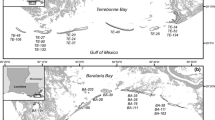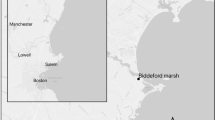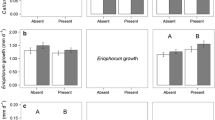Abstract
To predict the impacts of climate change, a better understanding is needed of the foundation species that build and maintain biogenic ecosystems. Spartina alterniflora Loisel (smooth cordgrass) is the dominant salt marsh-building plant along the US Atlantic coast. It maintains salt marsh elevation relative to sea level by the accumulation of aboveground biomass, which promotes sediment deposition and belowground biomass, which accretes as peat. Peat accumulation is particularly important in elevation maintenance at high latitudes where sediment supply tends to be limited. Latitudinal variation in S. alterniflora growth was quantified in eight salt marshes from Massachusetts to South Carolina. The hypothesis that allocation to aboveground and belowground biomass is phenotypically plastic was tested with transplant experiments among a subset of salt marshes along this gradient. Reciprocal transplants revealed that northern S. alterniflora decreased allocation to belowground biomass when grown in the south. Some northern plants also died when moved south, suggesting that northern S. alterniflora may be stressed by future warming. Southern plants that were moved north showed phenotypic plasticity in biomass allocation, but no mortality. Belowground biomass also decomposed more quickly in southern marshes. Our results suggest that warming will lead northern S. alterniflora to decrease belowground allocation and that belowground biomass will decompose more quickly, thus decreasing peat accumulation. Gradual temperature increases may allow for adaptation and acclimation, but our results suggest that warming will lower the ability of salt marshes to withstand sea-level rise.








Similar content being viewed by others
References
Aerts, R. 2006. The freezer defrosting: global warming and litter decomposition rates in cold biomes. Journal of Ecology 94: 713–724.
Agren, J., and D.W. Schemske. 2012. Reciprocal transplants demonstrate strong adaptive differentiation of the model organism Arabidopsis thaliana in its native range. New Phytologist 19: 1112–1122.
Anisfeld, S.C., and T.D. Hill. 2012. Fertilization effects on elevation change and belowground carbon balance in a Long Island Sound tidal marsh. Estuaries and Coasts 35: 201–211.
Armstrong, W., E.J. Wright, S. Lythe, and T.J. Gaynard. 1985. Plant zonation and the effects of the spring-neap tidal cycle on soil aeration in a Humber salt marsh. Journal of Ecology 73: 323–339.
Barbier, E.B., S.D. Hacker, C. Kennedy, E.W. Koch, A.C. Stier, and B.R. Silliman. 2011. The value of estuarine and coastal ecosystem services. Ecological Monographs 81: 169–193.
Benner, R., M. Fogel, and E. Sprague. 1991. Diagenesis of belowground biomass of Spartina alterniflora in salt-marsh sediments. Limnology and Oceanography 36: 1358–1374.
Bertness, M.D. 1991. Zonation of Spartina patens and Spartina alterniflora in a New England salt marsh. Ecology 72: 138–148.
Bertness, M.D., and A.M. Ellison. 1987. Determinants of pattern in a New England salt-marsh plant community. Ecological Monographs 57: 129–147.
Bertness, M.D., and P.J. Ewanchuk. 2002. Latitudinal and climate-driven variation in the strength and nature of biological interactions in New England salt marshes. Oecologia 132: 392–401.
Blum, M.J., K. Jun Bando, M. Katz, and D.R. Strong. 2007. Geographic structure, genetic diversity and source tracking of Spartina alterniflora. Journal of Biogeography 34: 2055–2069.
Bouma, T.J., K. Hengst, B.P. Koutstaal, and J. van Soelen. 2002. Estimating root lifespan of two grasses at contrasting elevation in a salt marsh by applying vitality staining on roots from in-growth cores. Plant Ecology 165: 235–245.
Castillo, J.M., P. Leira-Doce, A.E. Rubio-Casal, and E. Figueroa. 2008. Spatial and temporal variations in aboveground and belowground biomass of Spartina maritima (small cordgrass) in created and natural marshes. Estuarine, Coastal and Shelf Science 78: 819–826.
Charles, H., and J.S. Dukes. 2009. Effects of warming and altered precipitation on plant and nutrient dynamics of a New England salt marsh. Ecological Applications 19: 1758–1773.
Chmura, G.L., S.C. Anisfeld, D.R. Cahoon, and J.C. Lynch. 2003. Global carbon sequestration in tidal, saline wetland soils. Global Biogeochemical Cycles 17: 1111.
Connell, J.H. 1961. The influence of interspecific competition and other factors on the distribution of the barnacle Chthamalus stellatus. Ecology 42: 710–723.
Connor, R., and G.L. Chmura. 2000. Dynamics of above-and belowground organic matter in a high latitude macrotidal saltmarsh. Marine Ecology Progress Series 204: 101–110.
Costanza, R., O. Perez-Maqueo, M.L. Martinez, P. Sutton, S.J. Anderson, and K. Mulder. 2008. The value of coastal wetlands for hurricane protection. AMBIO: A Journal of the Human Environment 37: 241–248.
Craft, C., J. Clough, J. Ehman, S. Joye, R. Park, S. Pennings, H. Guo, and M. Machmuller. 2009. Forecasting the effects of accelerated sea-level rise on tidal marsh ecosystem services. Frontiers in Ecology and the Environment 7: 73–78.
Darby, F.A., and R.E. Turner. 2008. Below- and aboveground Spartina alterniflora production in a Louisiana salt marsh. Estuaries and Coasts 31: 223–231.
Day, J.W., D.F. Boesch, E.J. Clairain, G.P. Kemp, S.B. Laska, W.J. Mitsch, K. Orth, H. Mashriqui, D.J. Reed, L. Shabman, and C.A. Simenstad. 2007. Restoration of the Mississippi Delta: lessons from hurricanes Katrina and Rita. Science 315: 1679–1684.
Dayton, P. 1972. Toward an understanding of community resilience and the potential effects of enrichments to the benthos at McMurdo Sound, Antarctica. In Proceedings of the Colloquium on Conservation Problems, 81–96. Lawrence: Allen Press.
Deegan, L.A., D.S. Johnson, R.S. Warren, B.J. Peterson, J.W. Fleeger, S. Fagherazzi, and W.M. Wollheim. 2012. Coastal eutrophication as a driver of salt marsh loss. Nature 490: 388–392.
Ellison, A.M., M.D. Bertness, and T. Miller. 1986. Seasonal patterns in the belowground biomass of Spartina alterniflora (Gramineae) across a tidal gradient. American Journal of Botany 73: 1548–1554.
Fitzgerald, D.M., M.S. Fenster, B.A. Argow, and I.V. Buynevich. 2008. Coastal impacts due to sea-level rise. Annual Review of Earth and Planetary Sciences 36: 601–647.
Gallagher, J.L. 1983. Seasonal patterns in recoverable underground reserves in Spartina alterniflora Loisel. American Journal of Botany 70: 212–215.
Gallagher, J.L., and F.G. Plumley. 1979. Underground biomass profiles and productivity in Atlantic coastal marshes. American Journal of Botany 66: 156–161.
Gallagher, J.L., G.F. Somers, D.M. Grant, and D.M. Seliskar. 1988. Persistent differences in two forms of Spartina alterniflora: a common garden experiment. Ecology 69: 1005–1008.
Gedan, K.B., A.H. Altieri, and M.D. Bertness. 2011. Uncertain future of New England salt marshes. Marine Ecology Progress Series 434: 229–237.
Gedan, K.B., B.R. Silliman, and M.D. Bertness. 2009. Centuries of human-driven change in salt marsh ecosystems. Annual Review of Marine Science 1: 117–141.
Gross, M.F., M.A. Hardisky, P.L. Wolf, and V. Klemas. 1991. Relationship between aboveground and belowground biomass of Spartina alterniflora (smooth cordgrass). Estuaries 14: 180–191.
Hoffmann, A.A., and C.M. Sgro. 2011. Climate change and evolutionary adaptation. Nature 470: 479–485.
Holdredge, C., M.D. Bertness, and A.H. Altieri. 2009. Role of Crab Herbivory in Die-Off of New England Salt Marshes. Conservation Biology 23: 672–679.
Howes, B.L., J.W. Dacey, and J.M. Teal. 1985. Annual carbon mineralization and belowground production of Spartina alterniflora in a New England salt marsh. Ecology 66: 595–605.
Kirwan, M.L., and L. Blum. 2011. Enhanced decomposition offsets enhanced productivity and soil carbon accumulation in coastal wetlands responding to climate change. Biogeosciences Discussions 8: 707–722.
Kirwan, M.L., G.R. Guntenspergen, and J.T. Morris. 2009. Latitudinal trends in Spartina alterniflora productivity and the response of coastal marshes to global change. Global Change Biology 15: 1982–1989.
Meade, R.H. 1982. Sources, sinks, and storage of river sediment in the Atlantic drainage of the United States. The Journal of Geology 90: 235–252.
Menge, B.A., E.L. Berlow, C.A. Blanchette, S.A. Navarrete, and S.B. Yamada. 1994. The keystone species concept: variation in interaction strength in a rocky intertidal habitat. Ecological Monographs 64: 249–286.
Morris, J.T., G. Shaffer, and J.A. Nyman. 2013. Brinson Review: Perspectives on the influence of nutrients on the sustainability of coastal wetlands. Wetlands 33: 975–988.
Morris, J.T., P. Sundareshwar, C.T. Nietch, B. Kjerfve, and D. Cahoon. 2002. Responses of coastal wetlands to rising sea level. Ecology 83: 2869–2877.
Newell, S.Y., L.K. Blum, R.E. Crawford, T. Dai, and M. Dionne. 2000. Autumnal biomass and potential productivity of salt marsh fungi from 29 to 43 North latitude along the United States Atlantic Coast. Applied and Environmental Microbiology 66: 180–185.
Nyman, J.A., R.J. Walters, R.D. Delaune, and W.H. Patrick Jr. 2006. Marsh vertical accretion via vegetative growth. Estuarine, Coastal and Shelf Science 69: 370–380.
Pennings, S.C., and M.D. Bertness. 2001. Salt Marsh Communities. In Marine Community Ecology, eds. M.D. Bertness, S.D. Gaines, and M.E. Hay, 289–316. Sunderland: Sinauer Associates.
Redfield, A.C. 1965. Ontogeny of a salt marsh estuary. Science 147: 50–55.
Redfield, A.C. 1972. Development of a New England salt marsh. Ecological Monographs 42: 201–237.
Roman, C.T., N. Jaworski, F.T. Short, S. Findlay, and R.S. Warren. 2000. Estuaries of the northeastern United States: habitat and land use signatures. Estuaries 23: 743–764.
Scheepens, J., E.S. Frei, and J. Stöcklin. 2010. Genotypic and environmental variation in specific leaf area in a widespread Alpine plant after transplantation to different altitudes. Oecologia 164: 141–150.
Schuerch, M., A. Vafeidis, T. Slawig, and S. Temmerman. 2013. Modeling the influence of changing storm patterns on the ability of a salt marsh to keep pace with sea level rise. Journal of Geophysical Research - Earth Surface 118: 84–96.
Shea, M., R.S. Warren, and W. Niering. 1975. Biochemical and transplantation studies of the growth form of Spartina alterniflora on Connecticut salt marshes. Ecology 56: 461–466.
Stocker, T.F., D. Qin, G.K. Plattner, M. Tignor, S.K. Allen, J. Boschung, A. Nauels, Y. Xia, V. Bex, and P.M. Midgley. 2013. Climate change 2013: The physical science basis. In Intergovernmental Panel on Climate Change, Working Group I Contribution to the IPCC Fifth Assessment Report (AR5). New York: Cambridge University Press.
Stumpf, R.P. 1983. The process of sedimentation on the surface of a salt marsh. Estuarine, Coastal and Shelf Science 17: 495–508.
Teal, J.M., and B.L. Howes. 1996. Interannual variability of a salt-marsh ecosystem. Limnology and Oceanography 41: 802–809.
Teal, J.M., and B.L. Howes. 2002. Salt marsh values: Retrospection from the end of the century. In Concepts and Controversies in Tidal Marsh Ecology, eds. M.P. Weinstein, and D.A. Kreeger, 9–19. Netherlands: Springer.
Turner, R.E., E. Swenson, and C. Milan. 2000. Organic and inorganic contributions to vertical accretion in salt marsh sediments. In Concepts and Controversies in Tidal Marsh Ecology, eds. M.P. Weinstein, and D.A. Kreeger, 583–595. Dordrecht: Springer.
Turner, R.E. 1976. Geographic variations in salt marsh macrophyte production: A review. Contributions in Marine Science 20: 47–68.
Turner, R.E., E.M. Swenson, C.S. Milan, J.M. Lee, and T.A. Oswald. 2004. Below-ground biomass in healthy and impaired salt marshes. Ecological Research 19: 29–35.
Valiela, I., J.M. Teal, S.D. Allen, R. Van Etten, D. Goehringer, and S. Volkmann. 1985. Decomposition in salt marsh ecosystems: the phases and major factors affecting disappearance of above-ground organic matter. Journal of Experimental Marine Biology and Ecology 89: 29–54.
Valiela, I., J.M. Teal, and W.G. Deuser. 1978. Nature of growth forms in salt-marsh grass Spartina alterniflora. American Naturalist 112: 461–470.
Valiela, I., J.M. Teal, and N.Y. Persson. 1976. Production and dynamics of experimentally enriched salt marsh vegetation: belowground biomass. Limnology and Oceanography 21: 245–252.
Voss, C.M., R.R. Christian, and J.T. Morris. 2013. Marsh macrophyte responses to inundation anticipate impacts of sea-level rise and indicate ongoing drowning of North Carolina marshes. Marine Biology 160: 181–194.
Weston, N.B. 2014. Declining sediments and rising seas: an unfortunate convergence for tidal wetlands. Estuaries and Coasts 37: 1–23.
White, K., J. Langley, D.R. Cahoon, and J.P. Megonigal. 2012. C3 and C4 Biomass Allocation Responses to Elevated CO2 and Nitrogen: Contrasting Resource Capture Strategies. Estuaries and Coasts 35: 1028–1035.
Acknowledgments
We thank M. Cockrell, A. Crosby, S. Ergun, J. Gallagher, K. Gedan, M. Ivens, D. Johnson, H. Nelson, D. Seliskar, L. Szathmary, G. Watson, and P. Williams for their invaluable assistance in the lab and field. C. Roman and D. Sax are thanked for their thoughtful comments on the manuscript. This research (or a portion thereof) was conducted in the National Estuarine Research Reserve System under an award from the Estuarine Reserves Division, Office of Ocean and Coastal Resource Management, National Ocean Service, and National Oceanic and Atmospheric Administration. Additional funding was provided to SCC by the National Park Service George Melendez Wright Climate Change Fellowship, an award to HML from the ADVANCE Program of Brown University (National Science Foundation Grant no. 0548311), and awards to LAD from the National Science Foundation (DEB-1354494, OCE-1238212) and the Northeast Climate Science Center (DOI-G12AC00001, DOI-G13AC00410).
Author information
Authors and Affiliations
Corresponding author
Ethics declarations
Conflict of Interest
The authors declare that they have no conflict of interest.
Additional information
Communicated by Nancy L. Jackson
Electronic supplementary material
ESM 1
(PDF 96.6 kb)
Rights and permissions
About this article
Cite this article
Crosby, S.C., Angermeyer, A., Adler, J.M. et al. Spartina alterniflora Biomass Allocation and Temperature: Implications for Salt Marsh Persistence with Sea-Level Rise. Estuaries and Coasts 40, 213–223 (2017). https://doi.org/10.1007/s12237-016-0142-9
Received:
Revised:
Accepted:
Published:
Issue Date:
DOI: https://doi.org/10.1007/s12237-016-0142-9




